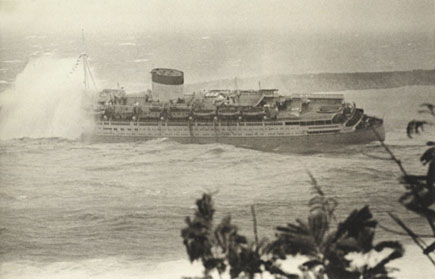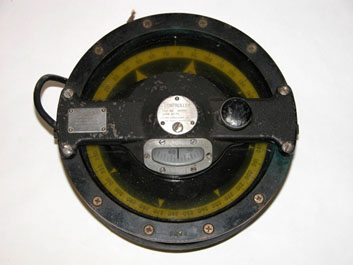The Largest Ship Salvage Operation in Corps History Took Place in Guam
In addition to its other waterways regulatory responsibilities, the U.S. Army Corps of Engineers is responsible for removing shipwrecks that menace navigation. In August 1974 the Corps was called upon to fulfill this duty when the 715-foot passenger ship Caribia sank in a storm and partially blocked the entrance to Apra Harbor in Guam. The ship was under tow en route from New York to Taiwan to be scrapped, and in the midst of Tropical Storm Mary, the tug towing the Caribia had to cut line in order to avoid grounding itself on a reef.
The Caribia was built as the Caronia by Cunard White Star Line. Built in Scotland, it made its inaugural voyage in 1949. Designed as a state-of-the-art luxury cruise ship, the Caronia sailed the world for twenty years. The ship was well known for its striking color scheme of four shades of green, its rakish yacht-inspired bow design, and very tall single funnel. By the mid 1960s, however, the Caronia faced stiff competition from newer ocean liners and a general decline in the cruise line market. In 1967 the ship made its final cruise for Cunard White Star. It was sold, refitted, and renamed the Caribia. It sailed twice under new ownership, but suffered a disastrous mechanical failure on its second cruise that sealed its fate. After five years at anchor in New York (where it incurred a “parking ticket”), it was sold for scrap. Unable to move under its own power, the Caribia was to be towed to Taiwan for scrap.
Following its sinking, neither Caribia’s owners nor the tug company took responsibility for the wreck. Because Guam depends on water transport for the necessities of life, it was imperative that the island’s only deep-draft harbor be fully reopened as soon as possible. The Corps’ Pacific Ocean Division (POD) took charge of the situation and managed the salvage project. The salvage operation was complicated by seeping oil from the wreck, not to mention a previously unknown wreck of a Navy landing craft containing fifty tons of ordnance needing removal as well. A $6.6 million contract was awarded for removal and scrapping/disposal of the vessel. The removal of the 34,000-ton ship, in approximately 400-ton sections, took two years. It was a sad end for a once proud ocean liner. As a memento of the largest salvage operation ever undertaken by the Corps, the Caribia’s compass was given to POD, which later transferred it to the Office of History, where it is now a part of the Corps’ museum collection.
 |
 |
| Caribia sinking in the entrance channel to Apra Harbor, Guam |
Compass removed from Caribia’s bridge |
*****
September 2004